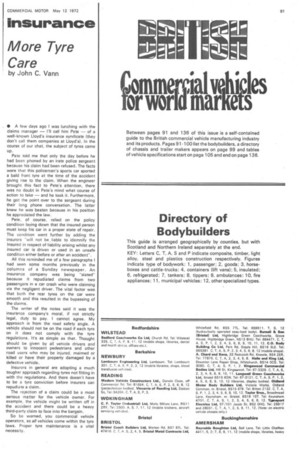Insurance More Tyre Care
Page 97

If you've noticed an error in this article please click here to report it so we can fix it.
by John C. Vann
• A few days ago I was lunching with the claims manager I'll call him Pete of a well-known Lloyd's insurance syndicate (they don't call them companies at Lloyd's). In the course of our chat, the subject of tyres came up.
Pete told me that only the day before he had been phoned by an irate police sergeant because his claim had been refused. The facts were that this policeman's sports car sported a bald front tyre at the time of the accident giving rise to the claim. When the engineer brought this fact to Pete's attention, there was no doubt in Pete's mind what course of action to take and he took it. Furthermore, he got the point over to the sergeant during their long phone conversation. The latter knew he was beaten because in his position he appreciated the law.
Pete, of course, relied on the policy condition laying down that the insured person must keep his car in a proper state of repair. The condition went further by adding the insurers "will not be liable to idemnify the Insured in respect of liability arising whilst any insured car is driven or used in an unsafe condition either before or after an accident".
All this reminded me of a few paragraphs I had seen some months previously in the columns of a Sunday newspaper. An insurance company was being "slated" because it repudiated claims from two passengers in a car crash who were claiming via the negligent driver. The vital factor was that both the rear tyres on the car were smooth and this resulted in the bypassing of the claims.
The writer of the notes said it was the insurance company's moral, if not strictly legal, duty to pay. I cannot agree. My approach is from the road safety angle. A vehicle should not be on the road if each tyre on it does not comply with the tyre regulations. It's as simple as that. Thought should be given by all vehicle drivers and owners to innocent pedestrians and other road users who may be injured, maimed or killed or have their property damaged by a defective vehicle.
Insurers in general are adopting a much tougher approach regarding tyres not fitting in with the regulations. And there doesn't have to be a tyre conviction before insurers can repudiate a claim.
The rejection of a claim could be a most serious matter for the vehicle owner. For example, the vehicle might be written off in the accident and there could be a heavy third-party claim to face into the bargain.
So be warned, you commercial vehicle operators, as all vehicles come within the tyre laws. Proper tyre maintenance is a vital necessity.
















































































































































































































